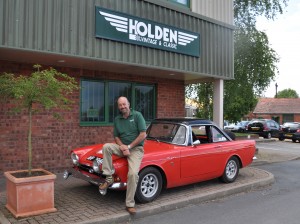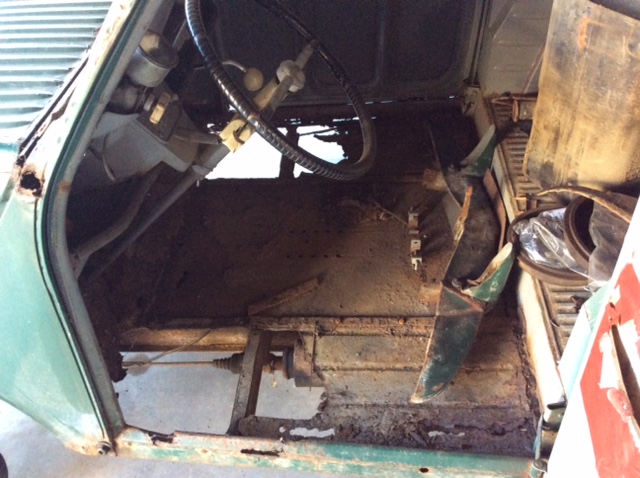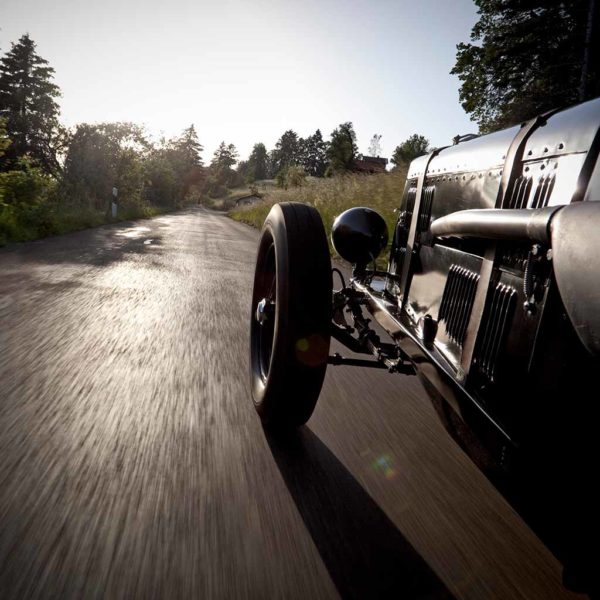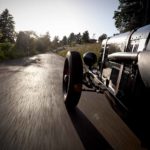Jeremy has bought one of five remaining from the seven originally built Works Competiton Department Rally Tigers…

Description: Sunbeam Tiger ex-Works Rally Car AHP 294B (1964)
Registration: AHP 294B
Year: 1964
Colour: Red
Engine size: 4,260 cc
Chassis No.: 9470014
Creating the Sunbeam Tiger
Inspired by the success of Carroll Shelby’s AC Cobra, leading US Rootes Group Dealer Ian Garrad, asked Shelby to turn the humble Sunbeam Alpine Roadster into a muscle car. A few prototypes later, the part-finished car was shipped from its home on the West Coast of America, back to England for input and appraisal by the racing boffins at Rootes. The collaboration resulted in The Tiger, which was launched in 1964, complete with a 4.2 litre Ford V8 engine; this was later switched for a 4.7 litre engine in the Mark Two version of 1967.
The Tiger was quickly earmarked for competition and made its debut at the San Martino di Castrozza Rally in Italy in September 1964. Only seven Works Rally Tigers were ever made, five of which survive to this day.
About Jeremy’s Model
Heralded as the most campaigned of the Works Tigers, this particular car has been driven by Maurice Gatsonides in the 1965 Monte Carlo Rally, as well as by Peter Harper in the 1966 Monte. Jeremy’s car (The AHP 294B) is from the first year of production in 1964 and features the original Ford 4.2 Litre V8 engine. It made its debut at the 1964 Geneva Rally, just three months after it was registered, where ‘Tiny’ Lewis and Barry Hughes took the controls and edged the car to victory. Two other Tigers also took part in the same race.
“AHP 294B” continued its competitive career the following year, tackling the Monte Carlo Rally at the hands of Maurice Gatsonides. Success didn’t follow, however, with the majority of the Paris starters – including Gatsonides – failing to finish; the car eventually became trapped in a snow drift in the Alps.
Unperturbed, Gatsonides took the car to Amsterdam to promote the sale of the road car, while also taking in a spell of endurance racing at the Zandvoort circuit. The Sunbeam performed admirably, shattering Dutch National Records in three, six, 12 and 24 hour categories. It averaged a speed of 75.47mph over the course of 23 hours, despite regularly pulling into the pit lane to be topped up with water. The car so impressed Gatsonides that he christened it “Thunderbus”.
After the successful record attempt at Zandvoort, Thunderbus went on to compete in the 1965 Tulip Rally with Peter Riley and Robin Turvey at the wheel. Unfortunately it ran out of time after being slowed by unseasonal snow when on racing tyres. In an effort to find some grip, Riley attempted one of the special uphill sections in a most bizarre manner, engaging reverse gear and driving the entire stage backwards! Sadly, such heroics were not enough and AHP was scratched from the event.
Later in 1965, now back with the combination of Tiny Lewis and Barry Hughes, AHP was again forced to retire from the Alpine Rally when the car caught fire. A rear brake shoe failed and the resulting debris damaged the hydraulics sending a jet of highly flammable brake fluid onto a hot brake drum with inevitable results. In the ensuing blaze, all the fire extinguishers were used up to quell the flames and the resulting damage is part of the reason why the car was returned to the Competition Department at Rootes and re-shelled with a brand new body later that year.
The Tiger would see much more racing over the following years, but perhaps the most exciting event came in 1967 when Vic Halen, who bought the car from the Rootes Group, entered the Spa-Francorchamps 1000km. Despite facing such sports-car racing legends as the Gulf-JW Automotive team of GT40-based Mirage M1 cars, the Ferrari Factory and factory supported privateer 330P4 and 412P sports prototypes, Factory Porsche 906 & 910 entries, plus a myriad of other famous cars such as Lola and Chapparal, the plucky Sunbeam finished 13th overall and 1st in the GT class.
The car passed through a number of hands before reaching its previous owner. SDuring this time rally legend Rosemary Smith has campaigned AHP 924B at the invitation of the owner and its last outing was during the Manx Classic in the mid-1990s, where it was driven by Classic & Sports Car’s Mick Walsh.
The Specification & Performance
As well as the 4.2 Litre Ford V8 Engine, the car had an original specification Rootes Group Sunbeam Alpine Roadster Body. Following the fire in 1965 however, the car was return to the Works Competition Department and modified to meet the newly-introduced 1966 rallying regulations. The regulations dictated that bonnet bulges and cut-outs to the wings were no longer allowed and a car’s silhouette had to mirror the production model.
With the new regulations in mind the factory carefully prepared two Tigers to a slightly different specification than had been used before. Engine preparation for the cars was close to the usual build, but with a high-lift cam, polished ports, etc. The major change was the fitting of a two-choke Ford modified carburettor and a cast-iron 289 inlet manifold, which replaced the four-barrel carburettor and alloy manifold and reduced engine power output to around 200bhp.
Subsequent testing at the MIRA test track revealed, however, that performance was little affected – when tested in August 1965, AHP (built to the same standard as FRW 667C, and later 668C), was only 0.5 seconds slower to 60mph and 1.5 seconds slower from 60-80mph in top gear than the 1965 Monte Carlo car, ADU 312, had been when tested in February 1965. Where the alterations really showed however, was in the breathing at higher revs. In the 0-90mph time the car was some 4 seconds slower, although what was lost in terms of acceleration appeared to be regained to some extent in flexibility, as the 60-70mph time in 3rd gear was similar.
Regarding the transmission and suspension, the usual 3.77 differential was fitted with a limited slip diff and both the front and rear spring rates were revised, along with the damper settings. As in the previous year’s Monte, the promise of cold and snowy conditions prompted the fitting of a heated windscreen and an alternator to help with the extra power loads, which also included the four extra forward-facing lamps.
A tyre contract with Dunlop had been negotiated and the car ran either with partly studded or fully studded SP44’s or SP41’s depending on the iciness of the sections.
What it’s like now…
Despite lying in dry storage with only light use, the car has remained in running order, although is far from competition ready. Found still wearing the same Rootes competition bodyshell it had in 1965, it also retains many period competition features including the 2.88:1 limited slip diff, the long-range saddle tank fitted in the boot, quick ratio steering rack, the original works hardtop badged “1966 Marathon de la Route”, period Halda rally instruments and the fly-off handbrake specially made for Peter Harper to aid his cornering technique. Indeed all the interior trim is original, including the driver’s seat which was specially tailored to suit Peter Harper’s long-shanked frame. It is currently being carefully inspected, sympathetically restored where needed and brought up to the required standard for active competition and will appear at the Tour Britannia 2015.





